PICKING UP THE PIECES
Exploring Reconstruction through Literature
Introduction | Background Knowledge | Activities | Extensions | Standards
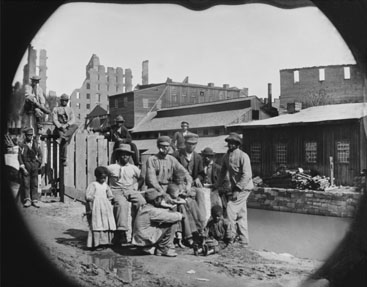
Introduction
Years before the Civil War, Abraham Lincoln famously said that "a house divided against itself cannot stand." That house fell during the Civil War. In the years after General Robert E. Lee surrendered at Appomattox Court House, the government had to figure out how to pick up the pieces of the fallen house. President Lincoln had set the stage for the reconciliation, which would come to be known as the Reconstruction. With Lincoln's assassination, President Andrew Johnson would be charged with bringing the former Confederate states back into the Union.
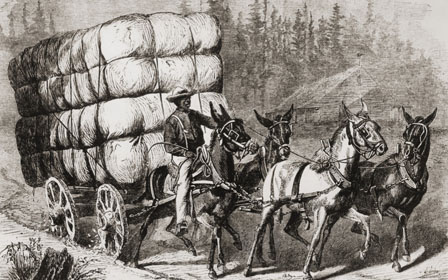
Background Knowledge
At the end of the Civil War, the United States faced the huge challenge of reuniting the nation. This era, from 1865 to 1877, is known as Reconstruction. Reconstruction was an unsettled time of change. The first hurdle that the US had to face was how to readmit the seceded states back into the Union. Lincoln did not believe that the Southern states had actually left the United States, so he did not believe that they had to be readmitted. This philosophical difference led to a number of political disagreements. In 1863, the Wade-Davis bill was introduced and passed by both chambers of Congress. Requiring citizens to take an "Ironclad Oath" proclaiming that they never supported the Confederacy was too stringent for Lincoln, and he vetoed the bill. The Reconstruction Acts passed in 1867 and 1868 allowed all seceded states to reenter the Union with strict conditions requiring the states to rewrite their constitutions. They were vetoed by President Andrew Johnson, but Congress overrode the veto and the legislation passed.
Protection for the freedmen was also a challenge during the Reconstruction Era. In March 1865, the Freedmen's Bureau was to help the freedmen with establishing their lives after being enslaved. They helped with basic needs - food, clothing, and shelter - as well as with labor contracts and with negotiating new relationships between former slaves and those who enslaved them. Born in North Carolina, President Johnson did not believe that Blacks should be involved in government and did not intervene when the Southern States began implementing Black Codes to replace their "slave codes." The Black Codes of the Reconstruction Era were short lived, but set up a culture of white political dominance in the South. President Johnson also blocked the passage of the 14th Amendment, which would add protections of the Civil Rights Act to the Constitution.
Andrew Johson was widely seen as an ineffective president and was replaced by General Ulysses S. Grant in the Election of 1868 with 52.7% of the popular vote. Grant went to work quickly by admitting 4 Southern states back to the Union and verifying that their state constitutions protected voting rights for all African-American as well as white men. Grant also pushed Congress to pass the Enforcement Acts of 1870 and 1871, which sought to protect people of African descent and support the Reconstruction governments in the Southern states. In addition, he created the Department of Justice and supported the department as they prosecuted the Klu Klux Klan.
One of the most significant pieces of legislation to come out of the Reconstruction Era was the Fourteenth Amendment in 1868. This amendment gave equal protection under the law to all citizens and defined citizenship. It overturned the Dred Scott decision of 1857, which denied citizenship to people of African descent. It also reversed the ⅗ compromise, which counted enslaved people as ⅗ of a person for representation in Congress. Finally, the third section banned anyone who participated in insurrection against the Constitution from holding office.
Another significant piece of legislation was the Fifteenth Amendment which passed in 1870 and ensured that men of all races would be eligible to vote. However, this amendment did not protect these new voters from the barriers that made it difficult to impossible for men of African descent to vote, such as poll taxes or literacy tests.
As the Reconstruction Era came to a close, the political landscape of the country was in transition. The political ideologies of the 1870s were starting to shift. Southern states continued to suppress and oppress African Americans while Northern states grew weary with the government involvement in Reconstruction. With the contested Election of 1876, Rutherford B. Hayes was elected president. The federal troops charged with overseeing Reconstruction in the South stood down, and government involvement waned, ending the Reconstruction Era.
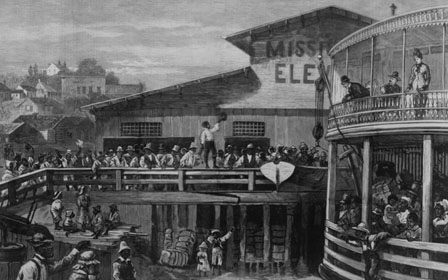
ACTIVITIES
Selective List of Picture Books
-
Ellen's Broom by Kelly Starling Lyons (ISBN 9780399250033)
- The Civil War is over, and Ellen's parents can go to the courthouse to have their marriage recognized in the eyes of the law. Mama tells the story of jumping the broom, and they decide to bring the broom with them to the courthouse. Ellen makes the broom a special part of the ceremony and the family. It is a great book about traditions.
- Use this discussion and activity guide to discuss the book in-depth and have students create their own brooms.
- Extend the story with Reader's Theater by Debbie Gonzales.
- Learn more about the Freedmen's Bureau and Marriage Records from the National Archives.
-
The Amazing Age of John Roy Lynch by Chris Barton (ISBN 9780802853790)
- John Roy Lynch was born "half Irish and all slave." During the Reconstruction, Lynch was elected to the House of Representatives and worked for equal rights for all people. This story is a well-written biography about John Roy Lynch.
- Discuss Lynch and his life's journey with this guide.
- John Roy Lynch was not the first or only African American to be elected to Congress. Learn more about some other trailblazers in this video from PBS.
- The House of Representatives keeps a biography of anyone who has served. Read John Roy Lynch's biography and create a timeline of his life.
- Technology Option: Create a digital timeline using TimelineJS (TeachersFirst review) or another timeline resource from this OK2Ask resource page.
- Non-Technology Option: Students can work in small groups and use bulletin board paper to create large timelines. Each student can use a different color ink to contribute to the timeline so teachers can easily see each child's contribution.
-
Abe Lincoln's Dream by Lane Smith (ISBN 9781596436084)
- Quincy meets Abraham Lincoln's ghost while on a trip to the White House. The restless spirit says that "there was a lot to be done after 1865." Quincy takes him to see the state of America, and Lincoln expresses how much work he wanted to do.
-
This book encourages reflection on the Reconstruction Era. Students can write about what they would tell Abraham Lincoln about America. How would they answer Lincoln's questions?
- Technology Option: Create a video using Adobe Express Video Maker (TeachersFirst review) so students can be the voice of Abraham Lincoln. They can upload a photograph of Lincoln from Pixabay (TeachersFirst review) and then record their thoughts as a voiceover. Students can also create the portraits linked below and upload pictures of the finished product.
- Non-Technology Option: Students can create portraits of Abraham Lincoln and attach their writing to their pictures.
-
No Small Potatoes: Junius G. Groves and His Kingdom in Kansas by Tonya Bolden (ISBN 9780385752763)
- Born into slavery in Kentucky, Junius G. Groves walked to Kansas to begin life as a free man. He started small, with only a few leased acres to farm. From there, he grew his farm until he was able to buy his own farm. He found himself about $1400 short and worked with dedication and perseverance to work off his debt in a year. He built his life by farming potatoes and left a legacy for his family.
- Junius G. Groves was an Exoduster. Examine primary sources from the Library of Congress using the Primary Source Analysis Tool.
- The Nicodemus National Historic Site in Kansas has photographs and videos that tell more about the Exoduster movement.
- Encourage cross-curricular learning with this learning guide.
-
Freedom's School by Lesa Cline-Ransom (ISBN 9781423161035)
- After Lizze's parents "woke up" free from slavery, she and her brother have the opportunity to go to school. When they arrive one day to see the school on fire, they sadly return home. A few weeks later, the community comes together to rebuild.
- The Encyclopedia of Virginia gives excellent information, including photographs and a timeline, about education in Virginia during Reconstruction. The New Georgia Encyclopedia and the NCPedia also provide information and pictures.
- Tolson's Chapel, in Maryland, served as a Freedmen's School.
Selective List of Chapter Books
-
Forty Acres and Maybe a Mule by Harriette Gillem Robinet (ISBN 9780689833175)
- Two young brothers, recently freed from slavery, seek the forty acres and a maybe a mule that the Freedmen's Bureau is advertising. As they settle into their new lives, the Klu Klux Klan threatens their freedom, their safety, and their peace.
- The publisher created a discussion guide that includes activities and opportunities for further research.
- Learn more about General Sherman's plan to lease the freed slaves forty acres of land with the opportunity for purchase in this video from PBS.
- After the Civil War, many newly freed people looked for family members that had been separated. Last Seen is a nonprofit that studies the stories of families that were torn apart by the slave trade. This activity helps students understand how word of mouth helped spread the information of wanted ads that many people were not able to read.
-
Brotherhood by Anne Westrick (ISBN 9780142422373)
- Shad lives in Richmond, Virginia. The Civil War has ended and Richmond is occupied by Union forces as Reconstruction begins. Shad and all of the males in his family are part of the Brotherhood or Klu Klux Klan. He believes in his family and the South, but also questions the Cause and his place in the Brotherhood. Set in the South and from a Southern perspective, this book represents the views and opinions of the time but allows the reader to feel Shad's internal conflict as he questions what he has always known.
- Best for mature 5th graders and above
-
A.B. Westrick, the author, provides a guided inquiry of Reconstruction using primary sources and the writer's workshop model. It is cross-curricular and encourages students to think critically about what they are seeing.
- Technology Approach - Use Marq (TeachersFirst review) to publish the articles that the students write.
- Non-Technology Approach - Use paper and pencil, writing notebooks, and printed copies of the primary sources.
-
The author also provides a discussion guide to help facilitate a class discussion.
- Technology Approach - Use Google Jamboard (TeachersFirst review) for students to have asynchronous discussions about the book.
Virtual Field Trips
- National Constitution Center
- The Reconstruction in Virginia
- The Museum of the Reconstruction Era in the Woodrow Wilson Family Home The virtual visit is compatible with Virtual Reality Goggles.
Videos to Watch
- Overview of Reconstruction by Bow Tie Guy and Wife
- Why Study Reconstruction by Facing History
- The World the War Made by Facing History
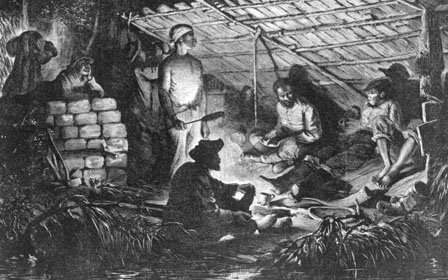
EXTENSIONS
-
Connect to Primary Sources
- The NIH and Smithsonian have teamed up to create a Learning Lab focused on the Reconstruction. Geared for middle school and up, elementary teachers can use parts of the resource to fit their students and curriculum.
-
Imagining Reconstruction Monuments
- In this Project Based Learning activity, students can identify an individual or event that played a significant role in reuniting the nation, helping it heal, and moving forward recognizing its newest citizens. Once chosen, students can draft sketches or use clay to create a statue to be a new monument.
-
Music in the Reconstruction Era
- The Fisk Jubilee Singers were founded in 1871 and shared "slave songs" with the world and helped solidify the genre of Negro Spirituals. Discuss the music as well as the legacy of the ensemble, which is discussed briefly in this video. The Library of Congress gives more information about Negro Spirituals and provides titles of the most well-known of the genre.
- The National Endowment for the Humanities created an EDSITEment site about African American Music. There are great resources and information housed here.
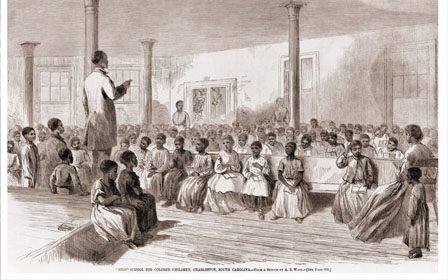
CORRELATION TO STANDARDS
-
AASL National School Library Standards
- Inquire Shared Foundation, Think Domain - Learners display curiosity and initiative by: 1. Formulating questions about a personal interest or a curricular topic. 2. Recalling prior and background knowledge as context for new meaning
- Inquire Shared Foundation, Grow Domain - Learners participate in an ongoing inquiry-based process by: 1. Continually seeking knowledge
- Include Shared Foundation, Create Domain - Learners adjust their awareness of the global learning community by:. 2. Evaluating a variety of perspectives during learning activities
- Include Shared Foundation, Grow Domain - Learners demonstrate empathy and equity in knowledge building within the global learning community by: 2. Demonstrating interest in other perspectives during learning activities
- Curate Shared Foundation, Create Domain - Learners gather information appropriate to the task by: 2. Collecting information representing diverse perspectives
- Explore Shared Foundation, Think Domain - Learners develop and satisfy personal curiosity by: 1. Reading widely and deeply in multiple formats and write and create for a variety of purposes. 2. Reflecting and questioning assumptions and possible misconceptions.
- Explore Shared Foundation, Share Domain - Learners engage with the learning community by: 1. Expressing curiosity about a topic of personal interest or curricular relevance
-
ISTE Standards for Students
- Knowledge Constructor - 3d. Students build knowledge by actively exploring real-world issues and problems, developing ideas and theories and pursuing answers and solutions.
